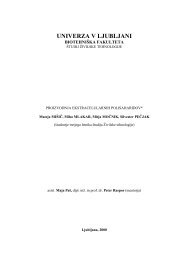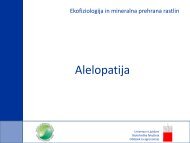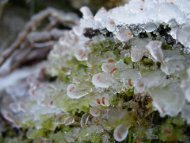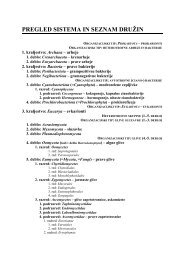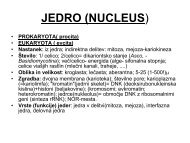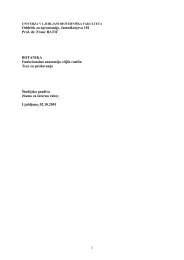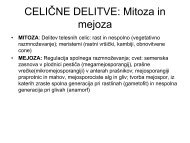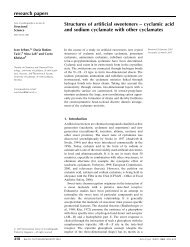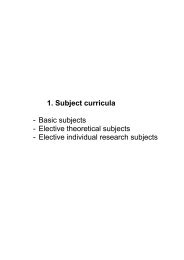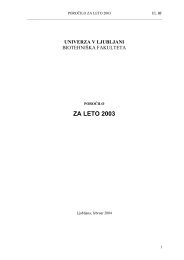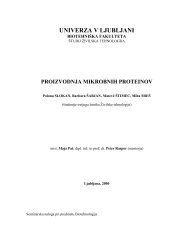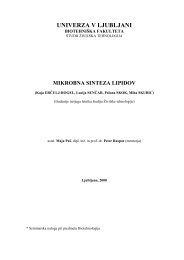MYCOTAXON
MYCOTAXON
MYCOTAXON
Create successful ePaper yourself
Turn your PDF publications into a flip-book with our unique Google optimized e-Paper software.
<strong>MYCOTAXON</strong><br />
Volume 108, pp. 287–296 April–June 2009<br />
Guignardia aesculi on species of Aesculus:<br />
new records from Europe and Asia<br />
Katarína Pastirčáková 1 *, Martin Pastirčák 2 ,<br />
Franci Celar 3 & Hyeon-Dong Shin 4<br />
*uefezima@hotmail.com<br />
1 Slovak Academy of Sciences, Institute of Forest Ecology<br />
Branch of Woody Plants Biology, Akademicka 2, SK-94901 Nitra, Slovakia<br />
2 Slovak Agricultural Research Centre, Research Institute of Plant Production<br />
Bratislavska cesta 122, SK-92168 Piestany, Slovakia<br />
3 University of Ljubljana, Biotechnical Faculty, Institute of Phytomedicine<br />
Jamnikarjeva 101, 1000 Ljubljana, Slovenia<br />
4 Korea University, College of Life Sciences and Biotechnology<br />
Division of Environmental Science and Ecological Engineering<br />
Seoul 136-701, Korea<br />
Abstract — New localities of Guignardia aesculi on leaves of seven Aesculus species<br />
(×carnea, flava, hippocastanum, ×neglecta, parviflora, pavia, turbinata) were recorded<br />
in Europe. The teleomorph was found on overwintered leaves of A. hippocastanum<br />
in Slovakia. The occurrence of the Guignardia leaf blotch on A. hippocastanum and<br />
A. turbinata was also confirmed for the first time in South Korea. The causal fungus<br />
Guignardia aesculi and its conidial anamorph Phyllosticta sphaeropsoidea and spermatial<br />
synanamorph Leptodothiorella aesculicola are described in detail and illustrated.<br />
Pathogenicity of the fungus was confirmed by inoculating horse chestnut leaves with<br />
conidia.<br />
Key words — Botryosphaeriaceae, Hippocastanaceae, morphology<br />
Introduction<br />
Guignardia aesculi (Botryosphaeriaceae) is a common leaf pathogen of various<br />
Aesculus species. It can almost totally defoliate trees through premature leaf fall.<br />
This pathogen causes serious damage of leaves (macular necrosis without leaf<br />
spot abscission) on young trees in nurseries. The symptoms (brown blotches<br />
on the leaves) can be confused with damage caused by a leaf-mining moth,<br />
Cameraria ohridella Deschka & Dimić. It is currently causing major problems<br />
in much of Europe, causing premature leaf fall, which looks very unattractive.<br />
However, numerous pin-point black dots (pycnidia) in the necrotic tissue<br />
distinguish blotch from insect damage and scorch due to drought or salt. Recent
288 ... Pastirčáková & al.<br />
invasion of a powdery mildew, Erysiphe flexuosa (Peck) U. Braun & S. Takam.,<br />
in Europe, has been thoroughly documented (Zimmermannová-Pastirčáková<br />
et al. 2002, Kiss et al. 2004, Bolay 2005, Põldmaa 2006, Stoykov and Denchev<br />
2008).<br />
Guignardia aesculi is distributed in North America and Eurasia. Most of<br />
the published records include only the anamorph and the spermatial state of<br />
the fungus, but the teleomorph has been recorded in USA (Peck 1887, Stewart<br />
1916), Western Germany (Schneider 1961), and England (Hudson 1987). The<br />
distribution of the fungus in Asia as well as the teleomorph has been very<br />
poorly studied. There are no modern detailed descriptions of all the different<br />
states of G. aesculi available.<br />
This contribution deals with morphology, pathology, host range, and<br />
geographical distribution of the causal agent of horse chestnut leaf blotch.<br />
Material and methods<br />
Collections and microscopic observations — Living leaves of Aesculus ×carnea<br />
Hayne, A. flava Sol., A. hippocastanum L., A. ×neglecta Lindl., A. parviflora Walter, A.<br />
pavia L. and A. turbinata Blume naturally infected with the anamorph of Guignardia<br />
aesculi were collected in 2000–08 in ten European countries (Austria, Belgium, Croatia,<br />
Czech Republic, Hungary, The Netherlands, Poland, Russia, Slovakia, Slovenia), USA,<br />
and South Korea. Regular collecting of overwintered leaves was conducted to find the<br />
teleomorph of the fungus. In castle park in Ivanka pri Dunaji, Slovakia, a number of A.<br />
hippocastanum trees naturally infected with G. aesculi were marked in the autumn of<br />
2000. The fallen infected leaves of A. hippocastanum lying on the ground were collected<br />
every 14 days in March and April 2001. Sampling was repeated in March and April 2008<br />
in four Slovak localities (Bratislava, Giraltovce, Leopoldov, Nitra).<br />
All samples were examined by a stereo (SZ51, Olympus, Tokyo, Japan) and a<br />
compound microscope (BX51, Olympus, Tokyo, Japan). Slide preparations were stained<br />
with lactophenol blue solution (Merck, Darmstadt, Germany). The observed characters<br />
were compared to previously published descriptions and documented photographically<br />
along with symptoms of attack.<br />
Herbarium specimens were deposited in the herbarium of Institute of Forest Ecology<br />
SAS, Nitra, Slovakia. Selected specimens were deposited in the mycological herbarium<br />
of Slovak National Museum, Bratislava, Slovakia (BRA) and at the U.S. National Fungus<br />
Collections, USA (BPI). Collections from Slovenia were deposited in the private<br />
herbarium of F. Celar.<br />
Isolation and inoculation — The fungus was isolated from samples of infected<br />
leaves of A. hippocastanum collected in Kračúnovce, Slovakia, in July 2000. Leaf tissue<br />
pieces with lesions were surface sterilized with 0.5% NaOCl for 1 min. Small pieces<br />
of tissue were excised, transferred to Petri dishes containing malt extract agar (Merck,<br />
Darmstadt, Germany), and incubated at 23±2°C. Colonies growing from the tissue<br />
pieces were subcultured onto malt extract agar and rice agar after five days. Test cultures<br />
were incubated on plates for two weeks.
Guignardia aesculi in Europe & Asia ... 289<br />
To confirm the fungus pathogenicity and fulfill Koch’s postulates, 3-yr-old seedlings<br />
of A. hippocastanum were inoculated with a Phyllosticta isolate. Healthy leaves of ten<br />
seedlings growing in plant pots in greenhouse were sprayed with the conidial suspension<br />
of the Phyllosticta anamorph of 2×10 5 conidia/ml to runoff with a hand-held atomizer.<br />
The inoculated leaves were covered with test tubes and the opening of the tubes plugged<br />
with cotton for four days. Five non-inoculated seedlings were used as a control and<br />
maintained in the same conditions in another compartment in greenhouse.<br />
Taxonomic description<br />
Guignardia aesculi (Peck) V.B. Stewart, Phytopathology 6: 9, 1916<br />
≡ Laestadia aesculi Peck, Ann. Rep. N.Y. St. Mus. Nat. Hist. 39: 51, 1887<br />
≡ Botryosphaeria aesculi (Peck) M.E. Barr, Contr. Univ. Mich. Herb. 2: 561, 1972<br />
Anamorph: Phyllosticta sphaeropsoidea Ellis & Everh., Bull. Torrey Bot. Club 10: 97, 1883<br />
≡ Phyllostictina sphaeropsoidea (Ellis & Everh.) Petr., Sydowia 10: 265, 1957<br />
?= Phyllosticta paviae Desm., Ann. Sci. Nat., Bot., sér. 3, 8: 32, 1847<br />
Synanamorph: Leptodothiorella aesculicola (Sacc.) Sivan., Bitunic. Ascomyc.: 165, 1984<br />
≡ Phyllosticta aesculicola Sacc., Michelia 1: 134, 1878<br />
≡ Asteromella aesculicola (Sacc.) Petr., Sydowia 10: 266, 1957<br />
= Phyllosticta aesculi Ellis & G. Martin, J. Mycol. 2: 130, 1886<br />
Representative specimens examined — On leaves of Aesculus ×carnea, AUSTRIA:<br />
Tulln, 18 Oct 2001, leg. K. Pastirčáková (BRA CR9831); Vienna, city centre, 12 Sep<br />
2002, leg. M. Pastirčák (BPI 871186); CZECH REPUBLIC: Prague, Mala Strana, 10 Sep<br />
2002, leg. K. Pastirčáková; HUNGARY: Budapest, Orlay utca, Várkert Rakpart, 19 Aug<br />
2006, leg. K. Pastirčáková; SLOVAKIA: Rimavská Sobota, city park, 24 Aug 2001, leg.<br />
K. Pastirčáková (BPI 871185); SLOVENIA: Ljubljana, Rožna dolina, near old Tobacco<br />
factory, Sep 2002, leg. F. Celar.<br />
On leaves of Aesculus flava, SLOVENIA: Ljubljana, near National Institute of Biology,<br />
May 2008, leg. F. Celar.<br />
On leaves of Aesculus hippocastanum, AUSTRIA: Tulln, 22 Sep 2001, leg. K. Pastirčáková<br />
(BRA CR9832); Tulln, near Institute for Agrobiotechnology, 18 Oct 2001, leg. M.<br />
Pastirčák (BPI 871183); BELGIUM: Plankendaal, 10 Aug 2001, leg. M. Lemmens;<br />
CROATIA: Zagreb, Cmrok, park, 20 Sep 2001, leg. D. Diminić; CZECH REPUBLIC:<br />
Prague, city centre, 10 Sep 2002, leg. K. Pastirčáková (BPI 871181); HUNGARY:<br />
Budapest, Döbrentei tér, Várkert Rakpart, 19 Aug 2006, leg. K. Pastirčáková; THE<br />
NETHERLANDS: Wageningen, 10 Oct 2001, leg. A.M. de Haas; POLAND: Lublin, park,<br />
9 Nov 2000, leg. K. Pastirčáková; RUSSIA: Saint-Petersburg, Ploschad Chenyshevskogo,<br />
22 Sep 2007, leg. K. Pastirčáková; SLOVAKIA: Kračúnovce, school park, 28 Jul 2000,<br />
leg. K. Pastirčáková (BRA CR9833); Ivanka pri Dunaji, castle park, 21 Sep 2000, leg.<br />
K. Pastirčáková; Giraltovce, city park, 20 Aug 2001, leg. K. Pastirčáková (BPI 871184);<br />
Bratislava, Rusovce, park, Mar–Apr 2008, leg. M. Pastirčák; Giraltovce, city park, Mar–<br />
Apr 2008, leg. M. Pastirčák; Leopoldov, city, Mar–Apr 2008, leg. M. Pastirčák; Nitra,<br />
Nábrežie mládeže, Mar–Apr 2008, leg. K. Pastirčáková; SLOVENIA: Ljubljana, Rožna<br />
dolina, near old Tobacco factory, Sep 2002, leg. F. Celar; SOUTH KOREA: National<br />
Arboretum, 30 Sep 2005, leg. K. Pastirčáková; USA: Grove City, Pennsylvania, 14 Oct<br />
2000, leg. P.M. Glova.<br />
On leaves of Aesculus ×neglecta, SLOVENIA: Arboretum Volčji Potok, Sep 2006, leg.<br />
F. Celar.
290 ... Pastirčáková & al.<br />
On leaves of Aesculus parviflora, AUSTRIA: Vienna, city park, 26 Oct 2001, leg. K.<br />
Pastirčáková; SLOVAKIA: Arboretum Mlyňany, 21 Jul 2001, leg. K. Pastirčáková;<br />
SLOVENIA: Ljubljana, Botanical Garden, Sep 2006, leg. F. Celar.<br />
On leaves of Aesculus pavia, SLOVENIA: Ljubljana, near National Institute of Biology,<br />
May 2008, leg. F. Celar.<br />
On leaves of Aesculus turbinata, SLOVENIA: Ljubljana, near Biotechnical faculty, Aug<br />
2007, leg. F. Celar; SOUTH KOREA: Forest Practice Research Center KFRI, 30 Sep<br />
2005, leg. K. Pastirčáková; Seoul, Gwanghwamun, 5 Oct 2005, leg. K. Pastirčáková.<br />
Symptoms — The first symptoms of leaf blotch disease, water-soaked irregular<br />
areas on living leaves, appear in May. Within a few days these turn reddish<br />
to brown, obtain a yellow border and coalesce. The lesions are variable in size<br />
and shape, often concrescent and cover extensive areas of the leaf. Minute<br />
black specks are seen scattered over the lesion (Figure 1A). Large lesions<br />
cause curling and distortion of leaflets. Small reddish brown elongate spots on<br />
petioles are also present.<br />
Microscopic features — Teleomorph (based on Slovak material):<br />
Pseudothecia on dead leaves in spring, subepidermal, globose to subglobose<br />
(Figure 2A), solitary, dark brown, wall of textura angularis with thick-walled<br />
cells of outer layers (Figure 2B), ostiolate, 90–180 µm in diameter, containing<br />
20–26 asci. Asci bitunicate, clavate to cylindrical, stalked, thickened and rounded<br />
at the apex, 8-spored, 55–80 × 16–28 µm (Figures 2C–2F). Ascospores onecelled,<br />
hyaline, straight or slightly curved, ovoid, ellipsoidal or rhomboidal,<br />
with a granular content, rarely guttulate, usually wider in the middle, 14–18 ×<br />
7–9 µm (Figures 2G–2I). Young ascospores possess mucilaginous cap-shaped<br />
appendages at one or both ends, which disappear at maturity. Pseudoparaphyses<br />
absent in mature pseudothecia.<br />
Anamorph: Pycnidia on leaf spots in living leaves in summer and autumn,<br />
on both surfaces of lesions, but much more on the upper surface, epiphyllous,<br />
single, globose to pyriform, dark brown, immersed, 80–160 µm in diameter,<br />
unilocular, ostiolate, wall of textura angularis (Figures 1B, 3A). Subcircular<br />
ostiole 10–18 µm in diameter, surrounded by conspicuous dark brown cells.<br />
Conidiogenous cells holoblastic, cylindrical or conical, hyaline. Conidia<br />
hyaline, coarsely granular, rarely guttulate, smooth, thin-walled, one-celled,<br />
globose, ellipsoidal, clavate or obpyriform, 9–18 × 6–12 µm, surrounded by<br />
a thin mucilaginous sheath, with a hyaline apical appendage, 6–8(–12) µm<br />
long (Figures 3B–3F). Conidia held together by the gelatinous substance seen<br />
extruding from the ostiole as a white coil.<br />
Synanamorph: Spermogonia similar in morphology to pycnidia, immersed,<br />
globose, dark brown, 40–95 µm in diameter. Spermatiogenous cells holoblastic,<br />
filamentous to cylindrical, long and slender. Spermatia one-celled, oblong<br />
cylindrical to dumb-bell shaped, hyaline, guttulate, straight or slightly curved,<br />
3–10 × 0.5–2.5 µm (Figure 3G).
Guignardia aesculi in Europe & Asia ... 291<br />
Figure 1. Guignardia leaf blotch. (A) a blotch with numerous pycnidia on naturally infected leaf of<br />
Aesculus hippocastanum; (B) pycnidia of the Phyllosticta anamorph in the necrotic tissue as viewed<br />
with a hand lens. Scale bar = 200 µm.<br />
Figure 2. Guignardia aesculi. (A) pseudothecium with asci; (B) wall of pseudothecium of textura<br />
angularis with thick-walled cells of outer layers; (C) a cluster of mature asci; (D–F) bitunicate asci<br />
and ascospores; (G–I) ascospores. Scale bars = 40 µm (A), 20 µm (B), 30 µm (C), 10 µm (D–I).
292 ... Pastirčáková & al.<br />
Colonies: Isolates produced different colonies on malt extract agar and rice<br />
agar (Figure 4). Colonies grew slowly, on malt extract agar: aerial mycelium<br />
woolly, white, hyphae branched, septate, hyaline, 4–6 µm in wide (Figure 3H),<br />
dark pycnidia clustered, aggregated; on rice agar: aerial mycelium scanty,<br />
pycnidia abundant, dark, globose, solitary, rarely clustered, with conidial and<br />
spermatial cavities; ascomata not produced in culture. Cultural characters and<br />
the effect of different nutrient media, their pH value and the ultraviolet radiation<br />
on mycelial growth and sporulation in isolates of P. sphaeropsoidea have been<br />
described in an earlier paper (Zimmermannová-Pastirčáková 2003).<br />
The fungus was identified as Guignardia aesculi on the basis of the characteristics<br />
described above. The morphological features of the teleomorph, anamorph<br />
and spermatial state observed in the collections from seven species of Aesculus<br />
(A. ×carnea [hippocastanum × pavia], A. flava, A. hippocastanum, A. ×neglecta<br />
[flava × sylvatica], A. parviflora, A. pavia and A. turbinata) correspond to those<br />
reported in previous publications (Stewart 1916, Sivanesan 1984, Punithalingam<br />
1993).<br />
The pycnidial anamorph was found in all examined samples. The spermatial<br />
state was found in most of the specimens, except for those of A. hippocastanum<br />
collected in Croatia and Czech Republic. Spermatia can be found in the same<br />
pycnidium together with Phyllosticta conidia (Treigiene 2006). A spermogonium<br />
has frequently been reported to develop immediately next to and in the same<br />
stroma with pycnidium, the two being separated only by a thin membranous<br />
wall (Stewart 1916).<br />
The teleomorph was recorded on A. hippocastanum in Slovakia. The<br />
sexual fruiting bodies of the examined fungus were not present from June to<br />
November when the leaves were collected. The fungus forms pseudothecia in<br />
the old lesions during the winter and mature in the spring when new leaves<br />
are developing. Overwintering and formation of teleomorph of the fungus was<br />
repeatedly observed on naturally infected leaves of A. hippocastanum in 2001<br />
and 2008 in four localities in Slovakia. The mature pseudothecia with asci and<br />
differentiated ascospores were observed in Slovak specimens collected in April<br />
2001. In 2008 numerous mature pseudothecia were seen in lesions of specimens<br />
collected as early as 30th March. The description of the teleomorph based on<br />
these collections is given above.<br />
Pathogenicity — Typical symptoms of leaf blotch began to develop<br />
approximately 10 days after the inoculation of A. hippocastanum seedlings with<br />
conidia. The symptoms of leaves artificially inoculated were identical to those<br />
of naturally infected leaves in the field. Further, pycnidia with conidia appeared<br />
in the lesions after 7 days. Control plants remained healthy. The pathogenicity<br />
test revealed that the isolate of Phyllosticta sphaeropsoidea from leaves of<br />
A. hippocastanum from Slovakia was pathogenic and when re-isolated from
Guignardia aesculi in Europe & Asia ... 293<br />
Figure 3. The anamorphs of Guignardia aesculi. (A–F) Phyllosticta anamorph: (A) pycnidium;<br />
(B, E, F) conidia with a granular content and (C, D) conidia with guttulae and apical appendages.<br />
(G, H) Leptodothiorella synanamorph: (G) spermatia; (H) hyphae of anamorphic state in culture.<br />
Scale bars = 30 µm (A), 10 µm (B–G), 20 µm (H).<br />
Figure 4. Cultures of Phyllosticta anamorph of Guignardia aesculi, 14-d old, inoculated from<br />
leaves of Aesculus hippocastanum. (A) on malt extract agar, (B) on rice agar.<br />
successfully infected leaves, the fungus was identical to the initial isolate. Only<br />
A. hippocastanum seedlings were used for pathogenicity test because seedlings<br />
of other species could not be obtained.<br />
Hudson (1987) reported characteristic lesions on horse chestnut leaves 4–6<br />
weeks after inoculation with separate suspensions of conidia and ascospores.
294 ... Pastirčáková & al.<br />
Table 1. Global distribution of Aesculus species attacked by Guignardia aesculi<br />
Geographic region Aesculus spp. References<br />
Canada glabra, hippocastanum Bissett & Darbyshire 1984<br />
USA ×ambigua, arguta, ×arnoldiana, Neely & Himelick 1963,<br />
×bushii, californica, ×carnea, Neely 1971,<br />
North<br />
chinensis, discolor, flava,<br />
Farr et al. n.d.<br />
America<br />
georgiana, glabra, ×glaucescens,<br />
hippocastanum, ×hybrida,<br />
×mutabilis, ×neglecta,<br />
parviflora, pavia, splendens,<br />
turbinata, ×woerlitzensis<br />
Austria ×carnea, hippocastanum, Petrak 1957,<br />
parviflora<br />
this paper<br />
Bulgaria, Croatia, hippocastanum Scaramuzzi 1954, Milatović 1956,<br />
Estonia, Italy,<br />
van der Aa 1973, Fakirova 1993,<br />
Lithuania,<br />
Andrianova 2006, Põldmaa 2006,<br />
Norway, Poland,<br />
Talgø et al. 2006, Treigiene 2006,<br />
Romania, Russia,<br />
Ukraine<br />
this paper<br />
Europe<br />
Asia<br />
Belgium,<br />
England<br />
Czech Republic,<br />
Hungary, Portugal,<br />
Switzerland<br />
hippocastanum, indica,<br />
parviflora<br />
×carnea, hippocastanum<br />
France ×carnea, hippocastanum, indica,<br />
parviflora<br />
Grove 1935, Hudson 1987,<br />
Farr et al. n.d.<br />
Scaramuzzi 1954, Caetano 1985,<br />
Bolay 2000, Magyar & Tóth 2003,<br />
this paper<br />
Vegh & Le Berre 1991,<br />
Farr et al. n.d.<br />
Germany glabra, hippocastanum Schneider 1961, Farr et al. n.d.<br />
Netherlands<br />
californica, ×carnea,<br />
hippocastanum, indica,<br />
×mutabilis, ×neglecta, pavia,<br />
sylvatica, ×woerlitzensis<br />
de Haas pers. comm. 2001<br />
Slovakia ×carnea, hippocastanum, Hrubík 1976, Juhásová et al. 1998,<br />
parviflora, pavia<br />
Farr et al. n.d., this paper<br />
Slovenia ×carnea, flava, hippocastanum, Milatović 1956,<br />
×neglecta, parviflora, pavia,<br />
turbinata<br />
this paper<br />
Armenia hippocastanum Simonyan 1981<br />
China pavia Chen et al. 2007<br />
South Korea hippocastanum, turbinata This paper<br />
Stewart (1916) carried out successful cross inoculations of A. glabra Willd. and<br />
A. hippocastanum seedlings by ascospores, with incubation period from 10 to<br />
20 days, whereas inoculations of A. parviflora leaves with ascospores from A.<br />
hippocastanum failed. According to van der Aa (1973), inoculation experiments<br />
with conidia and ascospores of species of Guignardia have mostly shown that<br />
these are specific plant pathogens capable of infecting one host species or<br />
species of one host genus.<br />
Host range and distribution — The host range of G. aesculi is restricted to<br />
representatives from family Hippocastanaceae. Records of Phyllosticta paviae on
Guignardia aesculi in Europe & Asia ... 295<br />
Thuja occidentalis L. and Hamamelis sp. in USA (Farr et al. n.d.) are probably<br />
assignable to P. thujae Bissett & M.E. Palm and P. hamamelidis Cooke ex<br />
G. Martin, respectively. Table 1 provides a list of all species and hybrids of the<br />
genus Aesculus attacked by G. aesculi reported in North American, European<br />
and Asian countries based on data in the literature. There are no herbarium<br />
collections of this fungus on the Asiatic species A. assamica Griff. and A. parryi<br />
A. Gray and the Mexican species A. wilsonii Rehder deposited in mycological<br />
herbaria listed in the Index Herbariorum database, and no records on these<br />
hosts in the literature.<br />
For the first time we recorded Guignardia leaf blotch on A. ×carnea in<br />
Austria, Czech Republic and Hungary; on A. hippocastanum in Russia; and on<br />
A. parviflora in Austria and Slovakia. Six Aesculus species (A. ×carnea, A. flava,<br />
A. ×neglecta, A. parviflora, A. pavia, A. turbinata) are reported as new hosts<br />
for G. aesculi in Slovenia. The specimens from South Korea represent the first<br />
record of the species in the country and the third known locality from Asia.<br />
Acknowledgements<br />
The authors are grateful to Kadri Põldmaa (University of Tartu, Tartu, Estonia) and<br />
Marcin Piątek (Polish Academy of Sciences, Kraków, Poland) for critical comments<br />
on the manuscript, and for acting as peer reviewers. We sincerely thank Alwin M. de<br />
Haas (Plantenziektenkundige Dienst, Wageningen, The Netherlands), Marc Lemmens<br />
(Institute for Agrobiotechnology, Tulln, Austria), Danko Diminić (University of Zagreb,<br />
Zagreb, Croatia), and Paul M. Glova (Grove City, PA, USA) for kindly providing<br />
specimens. First author thanks Prof. Hyeon-Dong Shin (Korea University, Seoul, Korea)<br />
for the opportunity granted to visit South Korea. This study was supported by Scientific<br />
Grant Agency of the Ministry of Education of Slovak Republic and the Slovak Academy<br />
of Sciences, project No. 2/7026/27, and by Slovak Research and Development Agency<br />
under the contracts No. APVV-51-032604 and APVV-0421-07.<br />
Literature cited<br />
Aa HA van der. 1973. Studies in Phyllosticta I. Stud. Mycol. 5: 1–110.<br />
Andrianova TV. 2006. Worldwide movement of horse chestnut (Aesculus hippocastanum L.)<br />
anamorphic leaf pathogens: monitoring in Ukraine. In 8th International Mycological Congress.<br />
Queensland, Australia, p. 365.<br />
Bissett J, Darbyshire SJ. 1984. Phyllosticta sphaeropsoidea. Fungi Canadenses 280: 1–2.<br />
Bolay A. 2000. L’oïdium des marronniers envahit la Suisse. Rev. Suisse Vitic. Arboric. Hortic. 32:<br />
311–313.<br />
Bolay A. 2005. Les oïdiums de Suisse (Erysiphacées). Cryptog. Helv. 20: 1–176.<br />
Caetano MFF. 1985. Guignardia aesculi (Peck) Stew. – Uma nova doença do “Castanheiro da Índia”<br />
em Portugal. Agros 67: 15–18.<br />
Chen PC, Li YZ, Xu Y, Chi XZ, Yan W, Ju RT. 2007. Main pests in imported colored arbors and the<br />
occurrence. Forest Pest Dis. 26: 31–34.<br />
Fakirova VI. 1993. New data about the ascomycetous fungi of Bulgaria II. Fitologija 46: 58–61.<br />
Farr DF, Rossman AY, Palm ME, McCray EB. n.d. Fungal Databases, Systematic Mycology and<br />
Microbiology Laboratory, ARS, USDA. Retrieved September 12, 2008, [http://nt.ars-grin.gov/
296 ... Pastirčáková & al.<br />
fungaldatabases/].<br />
Grove WB. 1935. British Stem- and Leaf-Fungi (Coelomycetes). Vol 1. Sphaeropsidales. Walter Lewis<br />
University Press: Cambridge (UK). 488 pp.<br />
Hrubík P. 1976. Biotickí škodcovia cudzokrajných drevín. Lesnictví 1: 1–72.<br />
Hudson HJ. 1987. Guignardia leaf blotch of horsechestnut. Trans. Br. Mycol. Soc. 89: 400–401.<br />
Juhásová G, Hrubík P, Šamajová O, Klucsárová K, Ivanová H, Chladná A. 1998. Kalamitný výskyt<br />
Cameraria ohridella (Deschka & Dimić, 1986), (Lepidoptera, Gracillariidae) na Slovensku. Folia<br />
Oecol. 24: 171–179.<br />
Kiss L, Vajna L, Fischl G. 2004. Occurrence of Erysiphe flexuosa (syn. Uncinula flexuosa) on horse<br />
chestnut (Aesculus hippocastanum) in Hungary. Plant Pathol. 53: 245.<br />
Magyar D, Tóth S. 2003. Data to the Knowledge of the Microscopic Fungi in the Forests around<br />
Budakeszi (Buda Hills, Hungary). Acta Phytopathol. Entomol. Hung. 38: 61–72.<br />
Milatović I. 1956. Palež lišea Divljeg Kestena. Zasht. Bilja 38: 109–111.<br />
Neely D. 1971. Additional Aesculus species and subspecies susceptible to leaf blotch. Plant Dis.<br />
Rep. 55: 37–38.<br />
Neely D, Himelick EB. 1963. Aesculus species susceptible to leaf blotch. Plant Dis. Rep. 47: 170.<br />
Peck CH. 1887 (“1886”). Plants not before reported. Ann. Rep. N.Y. St. Mus. Nat. Hist. 39: 30–73.<br />
Petrak F. 1957 (“1956”). Über ein verheerendes Auftreten der Blattrollkrankheit der Rosskastanien<br />
in der südlichen Steiermark. Sydowia 10: 264–270.<br />
Põldmaa K. 2006. Two new parasitic ascomycetes on Aesculus hippocastanum in Estonia. Folia<br />
Cryptog. Estonica 42: 85–89.<br />
Punithalingam E. 1993. Guignardia aesculi. IMI Descriptions of Fungi and Bacteria No. 1165.<br />
Mycopathologia 123: 53–54.<br />
Scaramuzzi G. 1954. Sul seccume delle foglie d’Ippocastano. Ann. Sper. Agr. 8: 1265–1281.<br />
Schneider R. 1961. Untersuchungen über das Auftreten der Guignardia-Blattbräune der<br />
Rosskastanie (Aesculus hippocastanum) in Westdeutschland und ihren Erreger. Phytopathol.<br />
Z. 42: 272–278.<br />
Simonyan SA. 1981. Mikoflora botaničeskich sadov i dendroparkov Armjanskoj SSR. AN Armjan.<br />
SSR: Yerevan (Armenia). 234 pp.<br />
Sivanesan A. 1984. The Bitunicate Ascomycetes and their anamorphs. J. Cramer: Vaduz (Germany).<br />
701 pp.<br />
Stewart VB. 1916. The leaf blotch disease of horse-chestnut. Phytopathology 6: 5–20.<br />
Stoykov DY, Denchev CM. 2008. Erysiphe flexuosa (Erysiphales) in Bulgaria. In CM Denchev (ed.),<br />
New records of fungi, fungus-like organisms, and slime moulds from Europe and Asia: 1-6.<br />
Mycol. Balc. 5: 94–95.<br />
Talgø V, Herrero M, Stensvand A. 2006. To nye bladsjukdomar på hestekastanje. Park & Anlegg<br />
8: 34–35.<br />
Treigiene A. 2006. Species of Phyllosticta and their teleomorphs from Lithuania. Mikol. Fitopatol.<br />
40: 426–432.<br />
Vegh I, Le Berre A. 1991. Contribution à ľ étude biologique du Guignardia aesculi (Peck) V.B.<br />
Stewart, parasite des marronniers. PHM Rev. Hort. 318: 43–46.<br />
Zimmermannová-Pastirčáková K. 2003. Occurrence of horsechestnut leaf blotch and cultural<br />
characteristics of its causal agent – fungus Phyllosticta sphaeropsoidea, an anamorph of<br />
Guignardia aesculi. Folia Oecol. 30: 245–250.<br />
Zimmermannová-Pastirčáková K, Adamska I, Błaszkowski J, Bolay A, Braun U. 2002. Epidemic<br />
spread of Erysiphe flexuosa (North American powdery mildew of horse-chestnut) in Europe.<br />
Schlechtendalia 8: 39–45.




